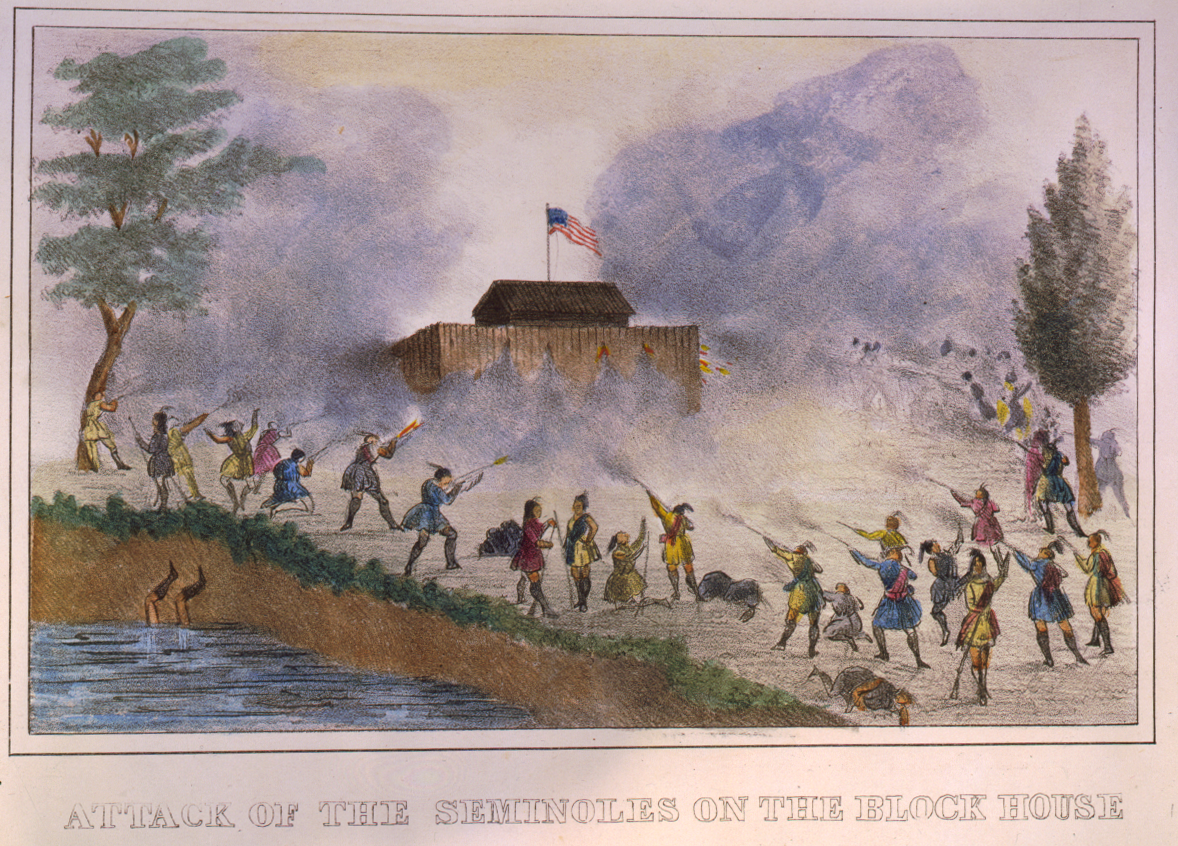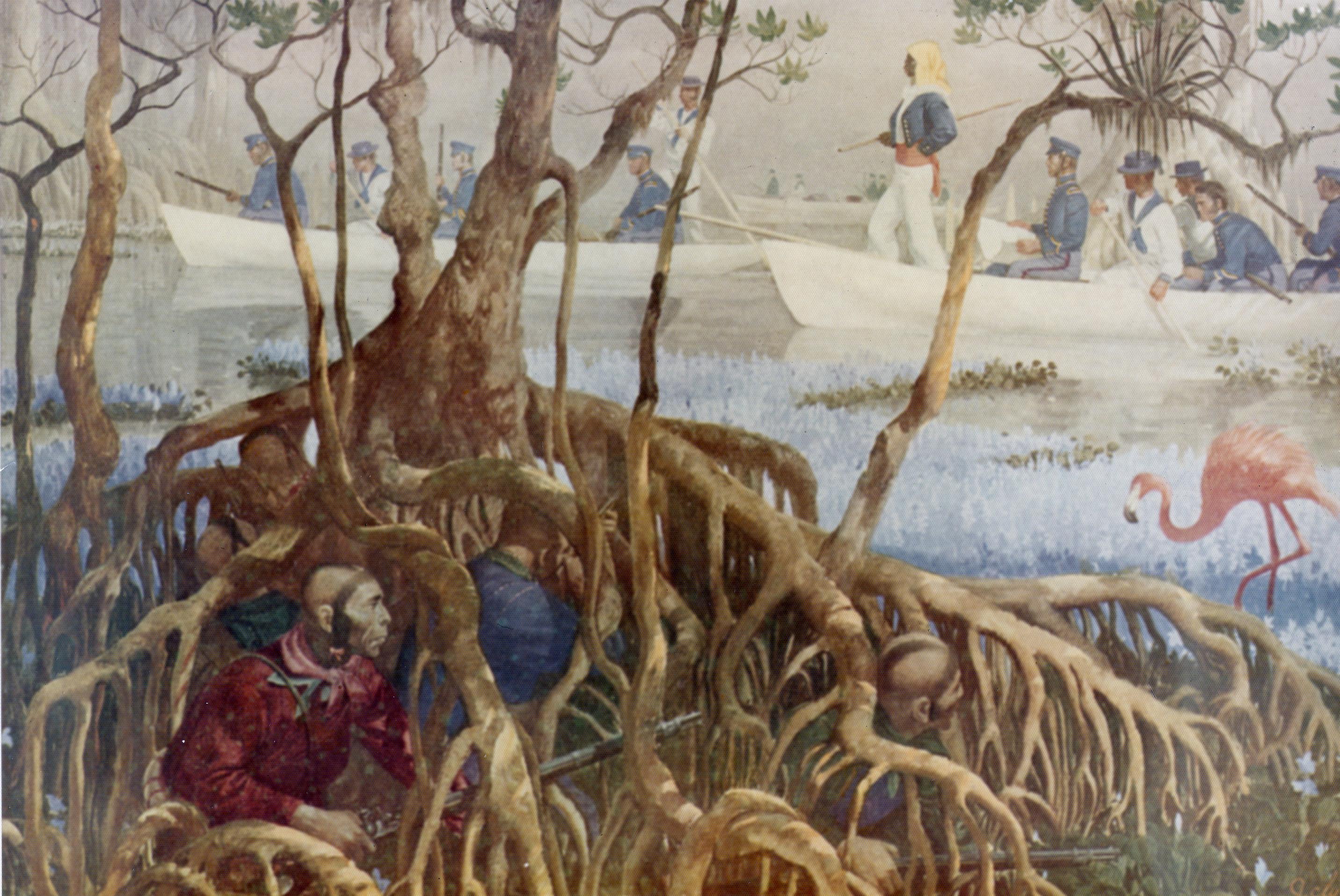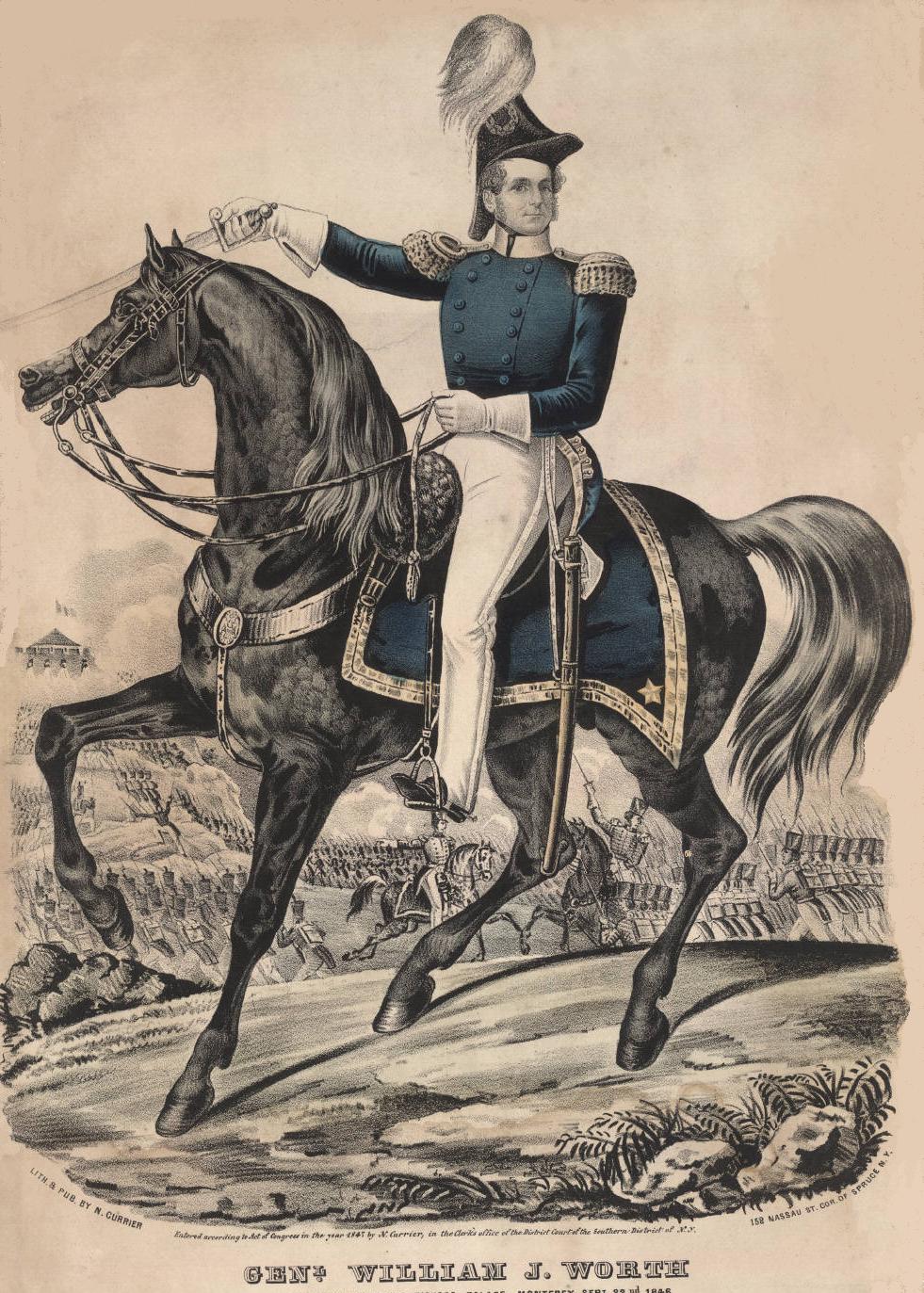|
Second Seminole War
The Second Seminole War, also known as the Florida War, was a conflict from 1835 to 1842 in Florida between the United States and groups of people collectively known as Seminoles, consisting of Muscogee, Creek and Black Seminoles as well as other allied tribes (see below). It was part of a series of conflicts called the Seminole Wars. The Second Seminole War, often referred to as ''the'' Seminole War, is regarded as "the longest and most costly of the American Indian Wars, Indian conflicts of the United States". After the Treaty of Payne's Landing in 1832 that called for the Seminoles' removal from Florida, tensions rose until fierce hostilities occurred in Dade battle, Dade's massacre in 1835. This engagement officially started the war although there were a series of incidents leading up to the Dade battle. The Seminoles and the U.S. forces engaged in mostly small engagements for more than six years. By 1842, only a few hundred native peoples remained in Florida. Although no pea ... [...More Info...] [...Related Items...] OR: [Wikipedia] [Google] [Baidu] |
Seminole Wars
The Seminole Wars (also known as the Florida Wars) were a series of three military conflicts between the United States and the Seminoles that took place in Florida between about 1816 and 1858. The Seminoles are a Native American nation which coalesced in northern Florida during the early 1700s, when the territory was still a Spanish colonial possession. Tensions grew between the Seminoles and American settlers in the newly independent United States in the early 1800s, mainly because enslaved people regularly fled from Georgia into Spanish Florida, prompting slaveowners to conduct slave raids across the border. A series of cross-border skirmishes escalated into the First Seminole War, when American general Andrew Jackson led an incursion into the territory over Spanish objections. Jackson's forces destroyed several Seminole, Mikasuki and Black Seminole towns, as well as captured Fort San Marcos and briefly occupied Pensacola before withdrawing in 1818. The U.S. and Spain soon ... [...More Info...] [...Related Items...] OR: [Wikipedia] [Google] [Baidu] |
William Henry Harrison
William Henry Harrison (February 9, 1773April 4, 1841) was the ninth president of the United States, serving from March 4 to April 4, 1841, the shortest presidency in U.S. history. He was also the first U.S. president to die in office, causing a brief constitutional crisis, since United States presidential line of succession, presidential succession was not then fully defined in the U.S. Constitution. Harrison was the last president born as a British subject in the Thirteen Colonies. He was a member of the Harrison family of Virginia, a son of Benjamin Harrison V, who was a Founding Fathers of the United States, U.S. Founding Father; he was also the grandfather of Benjamin Harrison, the 23rd U.S. president. Harrison was born in Charles City County, Virginia. In 1794, he participated in the Battle of Fallen Timbers, an American military victory that ended the Northwest Indian War. In 1811, he led a military force against Tecumseh's confederacy at the Battle of Tippecanoe, where ... [...More Info...] [...Related Items...] OR: [Wikipedia] [Google] [Baidu] |
Florida
Florida ( ; ) is a U.S. state, state in the Southeastern United States, Southeastern region of the United States. It borders the Gulf of Mexico to the west, Alabama to the northwest, Georgia (U.S. state), Georgia to the north, the Atlantic Ocean to the east, the Straits of Florida to the south, and The Bahamas to the southeast. About two-thirds of Florida occupies a peninsula between the Gulf of Mexico and the Atlantic Ocean. It has the List of U.S. states by coastline, longest coastline in the contiguous United States, spanning approximately , not including its many barrier islands. It is the only state that borders both the Gulf of Mexico and the Atlantic Ocean. With a population of over 23 million, it is the List of U.S. states and territories by population, third-most populous state in the United States and ranks List of states and territories of the United States by population density, seventh in population density as of 2020. Florida spans , ranking List of U.S. states ... [...More Info...] [...Related Items...] OR: [Wikipedia] [Google] [Baidu] |
William Jenkins Worth
William Jenkins Worth (March 1, 1794 – May 7, 1849) was an American officer during the War of 1812, the Second Seminole War, and the Mexican–American War. Early military career Worth was commissioned as a first lieutenant in March 1813, serving as an aide to (then brigadier general) Winfield Scott during the war, and developing a friendship with him. He later named his son Winfield Scott Worth. He distinguished himself at the battles of Chippewa and Lundy's Lane during the Niagara campaign. In the latter battle, he was seriously wounded by grapeshot in the thigh. He was not expected to survive, but after a year's confinement, he emerged with the breveted rank of Major—though he would remain lame for the rest of his life. Also as a brevet Major Worth uttered his most famous words that are now inscribed in West Point's "Bugle Notes", a book of knowledge all cadets must know by heart. They are as follows: After the war he was Commandant of Cadets at West Point and woul ... [...More Info...] [...Related Items...] OR: [Wikipedia] [Google] [Baidu] |
Walker Keith Armistead
Walker Keith Armistead (March 25, 1773 – October 13, 1845) was a military officer who served as Chief of Engineers of the United States Army Corps of Engineers. Armistead was born in Upperville, Fauquier County, Virginia, and served as an orderly sergeant at the Battle of Fallen Timbers. He graduated from West Point in 1803. During the War of 1812, he was promoted to lieutenant colonel and successively served as Chief Engineer of the Niagara frontier army and the forces defending Chesapeake Bay. He was promoted to colonel and Chief Engineer on November 12, 1818. When the Army was reorganized on June 1, 1821, he became commander of the 3rd Artillery Regiment. He was brevetted brigadier general in November 1828. He succeeded Zachary Taylor as commander of the army during the Second Seminole War against the Seminole Indians in Florida in 1840–1841. After 42 years of service as a commissioned officer, Armistead died in New Market, Virginia, at the age of 72, and is buri ... [...More Info...] [...Related Items...] OR: [Wikipedia] [Google] [Baidu] |
Zachary Taylor
Zachary Taylor (November 24, 1784 – July 9, 1850) was an American military officer and politician who was the 12th president of the United States, serving from 1849 until his death in 1850. Taylor was a career officer in the United States Army, rising to the rank of major general and becoming a national hero for his victories in the Mexican–American War. As a result, he won election to the White House despite his vague political beliefs. His top priority as president was to preserve the Union. He died 16 months into his term from a stomach disease. Taylor had the third-shortest presidential term in U.S. history and was the third president whose death has been traced to poor sanitation in Washington DC. Taylor was born into a prominent family of plantation owners who moved westward from Virginia to Louisville, Kentucky, in his youth. He was the last president born before the adoption of the Constitution. He was commissioned as an officer in the U.S. Army in 1808 and made ... [...More Info...] [...Related Items...] OR: [Wikipedia] [Google] [Baidu] |
Thomas S
Thomas may refer to: People * List of people with given name Thomas * Thomas (name) * Thomas (surname) * Saint Thomas (other) * Thomas Aquinas (1225–1274) Italian Dominican friar, philosopher, and Doctor of the Church * Thomas the Apostle * Thomas (bishop of the East Angles) (fl. 640s–650s), medieval Bishop of the East Angles * Thomas (Archdeacon of Barnstaple) (fl. 1203), Archdeacon of Barnstaple * Thomas, Count of Perche (1195–1217), Count of Perche * Thomas (bishop of Finland) (1248), first known Bishop of Finland * Thomas, Earl of Mar (1330–1377), 14th-century Earl, Aberdeen, Scotland Geography Places in the United States * Thomas, Idaho * Thomas, Illinois * Thomas, Oklahoma * Thomas, Oregon * Thomas, South Dakota * Thomas, Virginia * Thomas, Washington * Thomas, West Virginia * Thomas County (other) * Thomas Township (other) Elsewhere * Thomas Glacier (Greenland) Arts and entertainment * ''Thomas'' (Burton novel), a 1969 ... [...More Info...] [...Related Items...] OR: [Wikipedia] [Google] [Baidu] |
Alexander R
Alexander () is a male given name, name of Greek origin. The most prominent bearer of the name is Alexander the Great, the king of the Ancient Greek kingdom of Macedonia (ancient kingdom), Macedonia who created one of the largest empires in ancient history. Variants listed here are Aleksandar, Aleksander, Oleksandr, Oleksander, Aleksandr, and Alekzandr. Related names and diminutives include Iskandar (name), Iskandar, Alec, Alek, Alex, Alexsander, Alexandre (given name), Alexandre, Aleks (given name), Aleks, Aleksa (given name), Aleksa, Aleksandre, Alejandro, Alessandro, Alasdair, Sasha (name), Sasha, Sandy (given name), Sandy, Sandro, Sikandar (other), Sikandar, Skander, Sander (name), Sander and Xander; feminine forms include Alexandra, Alexandria (given name), Alexandria, and Sasha (name), Sasha. Etymology The name ''Alexander'' originates from the (; 'defending men' or 'protector of men'). It is a compound of the verb (; 'to ward off, avert, defend') and the no ... [...More Info...] [...Related Items...] OR: [Wikipedia] [Google] [Baidu] |
Richard Gentry (Missouri Politician)
Richard Gentry (August 25, 1788 – December 25, 1837) was an American politician, slave owner, and soldier from Missouri. Gentry was killed in Florida at the Battle of Lake Okeechobee during the Seminole Wars. The Missouri county of Gentry is named for him. He was the first mayor and founder of Columbia, Missouri. Early life Richard Gentry was born August 25, 1788, in Madison County, Kentucky (then part of Virginia) to parents Richard and Jane (Harris) Gentry, who were both of English descent. His father was a veteran of the American Revolutionary War who served in the Continental Army, and he had fought at the Siege of Yorktown. His father was also " wealthy in lands and slaves" and owned a plantation in Kentucky. Young Richard grew up a child of the frontier, skilled in hunting and tracking, skills that would well serve him later in his military career. At age 19, Richard Gentry was commissioned as a Lieutenant in the 19th Regiment of the Kentucky Militia and quickly prom ... [...More Info...] [...Related Items...] OR: [Wikipedia] [Google] [Baidu] |
Richard Keith Call
Richard Keith Call (October 24, 1792 – September 14, 1862) was an American attorney, politician, and enslaver who served as the 3rd and 5th territorial governor of Florida. Before that, he was elected to the Florida Territorial Council and as a delegate to the U.S. Congress from Florida. In the mid-1830s, he developed two plantations in Leon County, Florida, one of which was several thousand acres in size. In 1860, Call enslaved more than 120 people and enslaved the third-most people in the county.Thomas Blake, "Largest Slaveholders from 1863 Slave Census Schedules" Free pages, Rootsweb Call was also a opposed to Florida ... [...More Info...] [...Related Items...] OR: [Wikipedia] [Google] [Baidu] |
David Moniac
David Moniac (December 25, 1802November 21, 1836) was a United States Army soldier of Muscogee descent. He was the first Native American and first non-white graduate of any race from the United States Military Academy at West Point, New York in 1822.James Lamar Appleton, "David Moniac" ''Encyclopedia of Alabama'', 2007-2011, accessed 20 November 2013 He was born into a prominent family of Upper Creeks, and was related to major Creek leaders on both sides of his family. Moniac was also the first cadet to enter West Point from the new state of . Moniac resigned his commission in 1822 to manage his clan's property in Alabama, where he developed a cotton |
Winfield Scott
Winfield Scott (June 13, 1786May 29, 1866) was an American military commander and political candidate. He served as Commanding General of the United States Army from 1841 to 1861, and was a veteran of the War of 1812, American Indian Wars, Mexican–American War, and the early stages of the American Civil War. Scott was the Whig Party's presidential nominee in the 1852 election but was defeated by Democrat Franklin Pierce. He was known as Old Fuss and Feathers for his insistence on proper military etiquette and the Grand Old Man of the Army for his many years of service. Scott was born near Petersburg, Virginia, in 1786. After training as a lawyer and brief militia service, he joined the army in 1808 as a captain of the light artillery. In the War of 1812, Scott served on the Canadian front, taking part in the Battle of Queenston Heights and the Battle of Fort George, and was promoted to brigadier general in early 1814. He served with distinction in the Battle of Chippawa bu ... [...More Info...] [...Related Items...] OR: [Wikipedia] [Google] [Baidu] |





